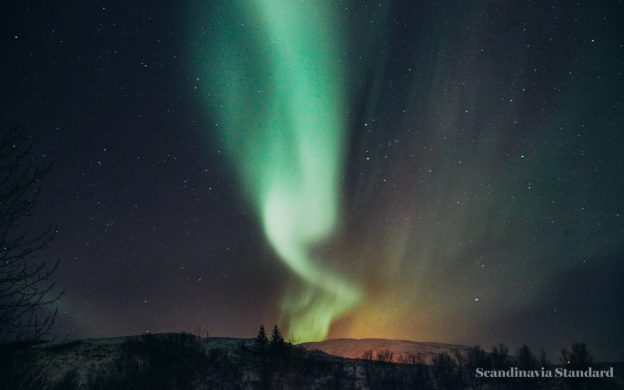The northern lights, also known as aurora borealis, are among the great natural wonders of the world; a staple on many travellers’ wish lists. I first heard about the northern lights when reading someone else’s bucket list as a kid. I didn’t know what they were but decided that they must belong on my bucket list, along with such gems as “bake a soufflé” and “take the midnight train going anywhere”.
What are the northern lights really? The bright dancing lights of the aurora are collisions between electrically charged particles from the sun that enter the Earth’s atmosphere. They’re sometimes visible, sometimes not. To me, they represent the unknowable aspects of this world and the strange forces that are at play in this universe that can’t be seen by the naked eye. The northern lights are a phenomenon that seem to straddle multiple worlds.
After dozens of failed attempts at seeing the lights, I began to suspect (privately) that it was a big conspiracy and that these lights only existed in long-exposure photography and the minds of overenthusiastic travellers living in a world of superlatives. And who likes fluorescent green anyway?
I headed to Iceland with G & T Weekends for their annual New Years in an Icelandic Lodge trip. Their epic itinerary included dog-sledding, swimming in thermal hot springs and a northern lights tour.
We spent the final day of the year visiting waterfalls, geysers and learning about the wonders of the elven folk. Afterwards we headed back to the lodge for a dip in the sauna, then cocktails while overlooking the Icelandic moonscape. It felt like the perfect end to the year.
 |
 |
 |
|
Then, half way through our New Year’s dinner, we were interrupted by the chef. He suggested that we go have a look outside. The rest of the crew ran, while I rather unenthusiastically minced outside while adjusting my camera settings.
Well, *cough*, I was wrong. BAM. There they were glowing across the horizon; clearer and brighter than I’d ever imagined. The pictures don’t do them justice. They move and shine and pulse. It’s difficult to not be moved by their energy.
So after years of attempts, how did I finally see the lights this time? Let’s break it down:
|
|
What’s the likelihood of seeing the northern lights?
It’s pretty complicated science; so complicated that I think it’s best to just share what I learnt from our bus driver. His knowledge of the lights was golden, as he narrowed it down to three basic conditions that are necessary:
 Clear Weather
Clear Weather
You’re not going to see the lights if there’s a thick cloud cover. The lights dance 80 kilometres above the Earth, well above the clouds. Sometimes they’re up to 640 kilometres high and they look ruby in colour. This map from the Northern Lights Forecast shows where the cloud cover is sitting.
People often say that the lights are best seen on “cold dark nights”. This is because the cold nights are less likely to have cloud over. Darkness is obviously important too, making winter the optimal time to see them because the sun actually goes down.
The official Aurora season in Iceland is from October to March but the word “official” doesn’t lend you any certainty. Like with so many things in Iceland, you must learn to “embrace the ambiguity”.
 Solar Activity
Solar Activity
There needs to be solar activity for the northern lights to appear. How do you know if there’s solar activity? You don’t. But the Aurora Forecast tells you on a scale of 0 to 9 how much aurora activity there is on a given day. There’s also an app. Science!
 |
 |
 Patience
Patience
Ahh, don’t forget patience! Some people see the northern lights the first time they try. For others like myself, it takes dozens of attempts. In the winter when there’s meant to be a lot of activity in the sky, there may be several weeks without sightings. They could come out at 10pm or 1am, and they could stay for 5 minutes or 5 hours.
The stoic philosopher Epictetus said “some things are up to us, and some things are not up to us.” Differentiating these two is the key; obviously the northern lights fall into the latter camp. So, all you can do is relax and focus on what you can control, like increasing your patience with the help of good music, a warm outdoor spa, and a nice bottle of wine or two.
My advice? Don’t go to Iceland for the northern lights; go for the place itself. Seeing the northern lights is like the icing on the cake. That’s the thing with many bucket list items: when you look back, you realise how many things happened when you least expected them.
Want to try your luck at seeing the northern lights? Reach out to G & T weekends about their New Years package.
 |
 |
 |
|

